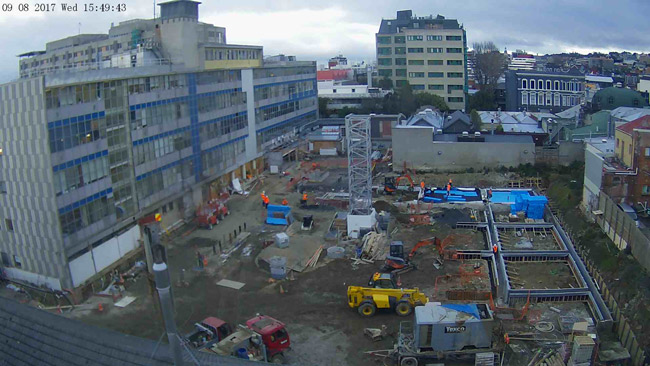
The site of the new Dentistry building – where a huge crane will be in use for the build.
A huge 50-metre tall tower crane is arriving this week at the site of the new Dentistry building – then two other cranes will assemble it.
The tower crane is higher than the 37-metre tall Forsyth Barr Stadium but will still be shorter than Dunedin's tallest building – the top of First Church's spire, which is 56.3 metres above the ground (the actual building is about 10 metres below that).
To anchor the tower crane, a section has already been embedded in 80 cubic metres of concrete on the construction site, behind the Faculty of Dentistry's existing Walsh Building in Great King Street, University of Otago Campus Development Division Director David Perry says.
The concrete pad will keep the Libherr crane stable while it uses its 45-metre long main boom to lift up to 12 tonne.
The tower crane is arriving from Smith Crane and Construction in Christchurch in six semi-trailers. It will be joined by two cranes from the company's yard in Invercargill – an all-terrain crane capable of lifting 100 tonne, and another that can lift 16 tonne.
When work starts early on Friday afternoon, the smaller crane will arrange and assemble the sections of the tower crane on the ground, and the larger crane will lift them into place, Mr Perry says.
A time-lapse web camera will provide a bird's-eye view of the activity; a link to it is on the University of Otago's website on the Faculty of Dentistry's new building project webpage.
The neighbouring Walsh Building will be closed for the weekend as a safety precaution.
Contractors should finish assembling the tower crane on Saturday – weather permitting – and will commission it on Sunday.
Tower cranes are used because they do not take up much room, can be built around and service the entire site.
On the construction site, the milestone first concrete slab will be poured soon, then the first 21-tonne pre-cast concrete wall panel will go up.
In other parts of the site, Leighs Cockram is installing micro piles and ground beams. More than 200 micro piles are already in place, and the total of 225 should be in the ground by the end of this month, Mr Perry says.
The micro piles will provide a very stable foundation for the nation's only dental school – which also treats patients from the community as part of students' training.
Where micro piling has finished on the site, Leighs Cockram has started making ground beams – from steel and concrete – that connect the piles in a grid pattern. The first foundation slab will be laid in one of those grids.
The site is also already home to a pit lined with concrete, which will house the machinery that will run the building's lifts.
The new Clinical Services Building is part of the Faculty's $130 million dollar extreme makeover, aimed at creating a world-class environment for patients, students and Otago's world-class researchers.
The project also involves redeveloping the Walsh Building, which will house research laboratories, academic and general staff offices, student learning spaces, student support, seminar rooms and teaching laboratories.
In the Clinical Services Building, about 60,000 treatments are performed every year on people from around the lower South Island.
The Clinical Services Building is expected to be finished in September next year and the Walsh redevelopment in late 2019. The two buildings will be linked by a new 1800 square metre atrium, Mr Perry says.
People urged to avoid Great King Street cul-de-sac where possible
A large volume of construction traffic is servicing two University construction sites in the Great King Street cul-de-sac so University Project Managers are encouraging people to avoid the area if possible to reduce congestion.
Work is ramping up on the Faculty of Dentistry's new build and redevelopment and the new Research Support Facility in the cul-de-sac between Frederick and Albany Streets, which already had a high level of pedestrian and traffic activity.
A Traffic Management Plan has been created for the area that includes an ongoing fluid mixture of signs, lower speed limits and kerbside fencing to meet changing needs.
Special adjustments are also made whenever large vehicles are being manoeuvred or significant deliveries are expected.
But, reducing the number of pedestrians and vehicles in the area would help as well.
People using the area are encouraged to be extra vigilant and mindful of their surroundings, and to take note of the instructions on the signs.
The new Dentistry building should be completed about September next year, then the Walsh Building refurbishment the following year. The Research Support Facility should be completed by early 2019.
